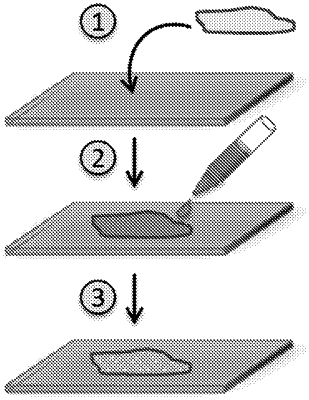| CPC G01N 33/573 (2013.01) [A61K 47/6849 (2017.08); A61K 47/6855 (2017.08); A61K 47/6889 (2017.08); A61K 49/0021 (2013.01); A61K 49/0058 (2013.01); C07K 16/2863 (2013.01); C07K 16/2896 (2013.01); G01N 33/57484 (2013.01); C07K 2319/50 (2013.01); C07K 2319/60 (2013.01); G01N 2333/95 (2013.01)] | 26 Claims |

|
1. A method of treating a patient with an activatable antibody, the method comprising:
(I) identifying a patient that is suitable for treatment with a second activatable antibody,
wherein a patient that is identified as suitable for treatment with a second activatable antibody is positive for the presence of a co-localized cleaving agent and a target in a tissue sample from the patient, as determined by an in situ assay, wherein the cleaving agent is a protease, and wherein the in situ assay comprises:
a) contacting the tissue sample with an uncleaved first activatable antibody, wherein the uncleaved first activatable antibody comprises:
(i) an antibody or antigen binding fragment thereof (AB) that specifically binds to the target;
(ii) a cleavable moiety (CM) coupled to the AB, wherein the CM is a polypeptide that functions as a substrate for the cleaving agent, whereby cleavage of the uncleaved first activatable antibody in the CM results in an activated first activatable antibody; and
(iii) a masking moiety (MM) coupled to the AB via the CM, wherein the MM of the uncleaved first activatable antibody interferes with specific binding of the AB to the target,
(b) measuring in situ the presence or absence of a detectable level of activated first activatable antibody in the tissue sample,
wherein presence of a detectable level of activated first activatable antibody in the tissue sample from the patient indicates that the patient is positive for the presence of co-localized cleaving agent and target, and
wherein absence of a detectable level of activated first activatable antibody in the tissue sample from the patient indicates that the patient is negative for the presence of co-localized cleaving agent and target, whereby the cleaving agent, the target, or both the cleaving agent and the target are absent or not co-localized at a detectable level in the tissue sample; and
(II) administering to the patient identified in step (I), a therapeutically effective amount of the second activatable antibody,
wherein the second activatable antibody comprises an AB that specifically binds to the same target, and a CM that functions as a substrate for the same cleaving agent, as the first activatable antibody in (a)(i) and (a)(ii), respectively, and wherein the second activatable antibody further comprises an MM, wherein the MM of the second activatable antibody interferes with specific binding of the AB to the target when the second activatable antibody is in an uncleaved state.
|